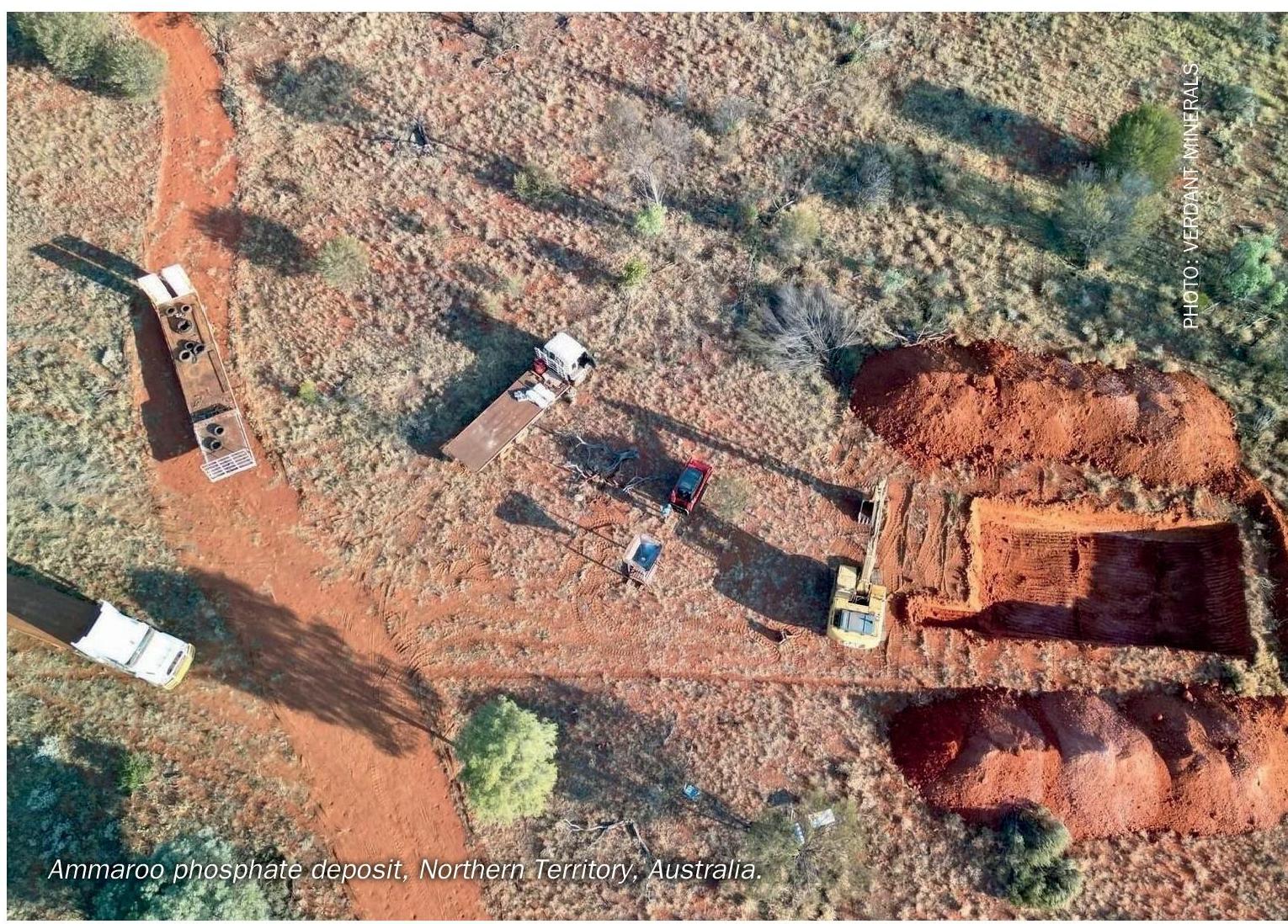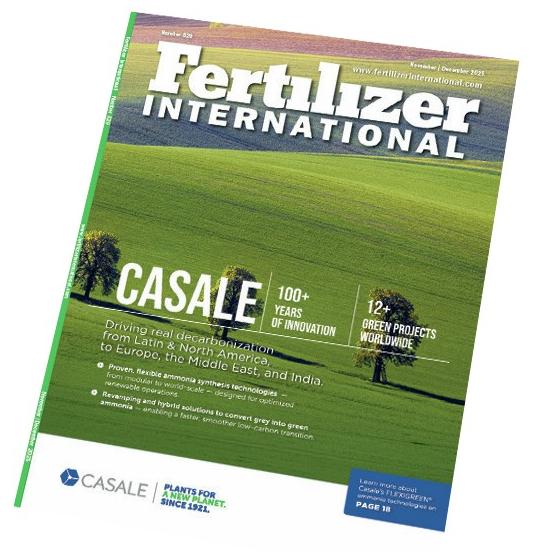Fertilizer International 519 Mar-Apr 2024

31 March 2024
State of the specialty market
MARKET REPORT
State of the specialty market
Specialty fertilizer products represent a small volume, high value segment of the overall fertilizer market that’s been growing at around four percent per annum in recent years. Economic, environmental, regulatory and agronomic imperatives are driving up their adoption – and an overall shift from volume to value in the fertilizer market.

The fertilizer market, fundamentally, remains a commodity market. The three major crop nutrients N, P and K, more often than not, are supplied through four main products: urea, diammonium phosphate (DAP), monoammonium phosphate (MAP) and potassium chloride (MOP). Combined world production of these long-standing, globally-traded commodities is north of 300 million tonnes annually.
Despite the continuing dominance of commodity fertilizers, the shift from volume to value in the market – also known as de-commoditisation – is a recognisable trend. This shift was highlighted by Amit Roy, the former president and CEO of the International Fertilizer Development Center (IFDC), almost a decade ago in his 2015 Francis New Lecture (Fertilizer International 467, p18).
From volume to value
For decades now, urea, DAP/MAP and MOP have been manufactured and internationally traded as standardised products. Their pricing reflects raw material/production/shipping costs – as well as the relative balance of supply and demand – rather than their quality, which is already priced in. Value is not generally added and consequently each commodity fertilizer sells at broadly the same price, regardless of the producer, with little, if any, attempt at product differentiation.
That paints a very stable and unchanging pictures of the fertilizer market. Yet something fundamental has changed in the last decade.
Yes, commodity fertilizer production remains the mainstay for most leading manufacturers. But looking at production scale and output in isolation can be deceptive.
Instead, as with any business, you need to follow the money. And when it comes to price premiums, higher margins and market growth, fertilizer producers are increasingly fixated on value-added products.
The Mosaic Company, North America’s largest phosphate producer makes a useful case study. Going back more than a decade, Mosaic was a classic commodity fertilizer producer with a largely traditional product offering based on DAP/MAP and MOP.
Since then, it has ramped-up production of its MicroEssentials premium product, a sulphur- and zinc-enriched specialty phosphate fertilizer. Similarly, Mosaic also signalled its shift away from commodity MOP by launching Aspire, a boron-enriched premium potash product, on the market in 2014.
The success of MicroEssentials is a textbook example of de-commoditisation and product differentiation. Mosaic has taken MAP, a standard commodity product and, by adding value, transformed it into a higher margin product with functional properties that confer a competitive advantage.
Mosaic has also overturned the assumption that specialty products are niche and small volume. Production of MicroEssentials has tripled since it first broke through the one million tonne threshold in 2013. MicroEssentials contributed around 2.8 million tonnes to Mosaic’s total phosphate sales volumes of 6.6 million tonnes in 2022 – a share of more than 40 percent – delivering a gross margin $33/t higher than its standard commodity sales.
Crucially, MicroEssentials has shown that specialty products can enter the mainstream and displace conventional commodity fertilizers in broad acre agriculture. Indeed, the product is now so ubiquitous it is applied to one in every 10 acres of cropland in the US.
This is a sign that the era of the ‘bulk speciality’ has arrived – and is no longer a contradiction in terms. It’s a term that Anglo American are using for their polyhalite product POLY4, for example, which the mining giant is planning to produce from its Woodsmith mine in the UK at scale of 13 million tonnes annually.
The shift away from commodities at Mosaic is mirrored by rival fertilizer producers. Increasing its capacity to produce and sell premium products is an integral part of Yara International’s future growth strategy, for example. Premium products able to deliver high margins – including compound NPKs, calcium nitrate, fertigation and micronutrient products – feature strongly in Yara’s fertilizer portfolio, being responsible for around two-fifths of its global sales volumes.
There is a clear financial imperative driving this. Premium products (NPKs and nitrates) generated a total premium of $1.8 billion for Yara in 2022 – versus the commodity alternatives – according to the company’s calculations.
The specialty fertilizer market is being keenly embraced by technology providers too. Companies such as Veolia and GEA (water-soluble fertilizers), Stamicarbon (controlled-release fertilizers), Shell Sulphur Solutions, thyssenkrupp and IPCO (sulphur-enhanced fertilizers) are helping fertilizer producers add premium products to their portfolios.
Drivers and imperatives
As well as generating higher margins and premiums, there are also environmental, agronomic and regulatory factors driving greater adoption of specialty products.
The poor nutrient use efficiency (NUE) of commodity fertilizers is spurring change, especially as farmers are currently paying the fertilizer industry for nutrients that never end up in their crops. Amit Roy, in his 2015 Francis New lecture, quoted an IFDC estimate of $116 billion annually for the total economic cost of lost/unused NPK nutrients applied in agriculture (Fertilizer International 467, p18).
N, P and K nutrient use efficiency (NUE) can range from 20-80 percent. Even under well-managed systems, NUE rarely exceeds 50 percent. These losses, we know, also have serious and damaging environmental consequences.
On climate, what we also know, from the recent Systemiq report commissioned by the International Fertilizer Society (IFA), is that improvements to NUE will need to do a lot of the heavy lifting in cutting agricultural N2 O emissions out to 2050 – with much greater use of enhanced efficiency fertilizers, such as inhibited or coated products, also being necessary1 .
“If these technologies were implemented with half of all mineral nitrogen fertilizer applied, it could cut greenhouse gas emissions by 100–200 Mt CO2 e in 2050, relative to a business-as-usual scenario,” reports Systemiq.
Then there is the agronomic necessity. To quote Amit Roy again:
“It is imperative that new, economically viable products are developed with nutrient-release properties that match crop requirements and contain essential plant-available secondary and micronutrients,” he said.
Roy argued that the known shortcomings of standard commodities, and the better agronomic performance and higher margins of specialty fertilizers, should makes it increasingly attractive for fertilizer producers to develop new product lines (Fertilizer International 467, p18).
“They are changing their business model from selling large quantities of the same product to one selling small quantities of new products that are more effective in terms of plant uptake and profitable for the company and the farmers,” Roy concluded.
Regulatory push
In Europe, policymakers are also having a significant impact on the balance of commodity versus specialty product use. Some are even asking whether clean air policies – namely the EU’s 2013 Clean Air Programme and the UK’s 2019 Clean Air Strategy – could eventually spell the end for standard commodity urea within Europe.
“There is no doubt among agronomists and fertilizer producers that enhanced urea fertilizers and urease additives will play a bigger role in arable farming because of the need to reduce ammonia losses under Europe’s clean air goals. But not every market observer is convinced,” commented Julia Meehan, managing editor for fertilizers at ICIS in 2020.
Germany has led the way. Despite consuming 2.2 million tonnes of urea in 2019, the EU’s powerhouse economy introduced a new fertilizer ordinance (Düngeverordnung) outlawing its straight use from 2020. This stipulates that:
“Urea as a fertiliser may, from 1 February 2020, only be spread insofar as a urease inhibitor is added to it or is worked in without delay or at the latest within four hours of spreading.”
The UK has followed Germany’s lead, albeit with a voluntary, industry-led approach.
After consulting with the farming industry on reducing ammonia emissions from urea, The UK’s environment department Defra is asking British farmers to use urea treated with an inhibitor for nine months of the year. Untreated or unprotected urea can only be applied to crops from 15th January to 31st March each year when cold and damp conditions prevail.
The new restrictions, while not having legal force, do apply to British farmers participating in the widely-adopted Red Tractor farm assurance scheme. This covers around 95 percent of urea use in the UK
Definitions and range of products
Rams & Co in its 2019 assessment of the global specialty fertilizer market for the International Fertilizer Association (IFA) covered the following product categories:
- Controlled-release fertilizers (CRFs)
- Slow-release fertilizers (SRFs), including both urea-reaction products and sulphur-coated urea (SCU)
- Stabilised fertilizers (SFs), usually urea, treated with an urease inhibitor (UI) and/or nitrification inhibitor (NI)
- Water-soluble fertilizers (WSFs) for hydroponics, fertigation systems or foliar application
- Liquid fertilizers for fertigation or soil and foliar application
- Micronutrient products (Zn, B, Mn, Cu, Fe, Mo, etc.), typically sulphates/ oxides or chelates (for improved soil mobility and plant availability).
The first three categories are grouped together as slow- and controlled-release and stabilised fertilizers (SCRSFs). Slightly confusingly, these three product types are also known as enhanced efficiency fertilizers (EEFs).
EEFs are defined by the Association of American Plant Food Control Officials (AAF-PCO) as: “Fertilizer products with characteristics that allow increased plant nutrient availability and reduce potential of nutrient losses to the environment when compared to an appropriate reference product.”
EEFs offer farmers distinct cost advantages over conventional commodity fertilizers. They achieve this by delivering significant savings in inputs, labour, energy and time, alongside potential yield improvements. Beneficially, they can also increase both nutrient and water use efficiency, and reduce the environmental impacts of applying fertilizers to land.
EEFs benefit crops by avoiding excess and potentially toxic levels of soil nutrients that occur when fertilizers dissolve too rapidly. They also moderate the environmental effects of fertilizer use by reducing nutrient losses, preventing nitrate leaching and NOx emissions, and curbing the volatilisation of ammonia.
To obtain the desired properties, such as slower or regulated nutrient release, the fertilizer content of EEF products is either modified chemically or physically encapsulated within a coating (Fertilizer International 480, p30)
How big is the specialty market?
In its 2018 assessment for the International Fertilizer Association (IFA), Rams & Co estimated that specialty products were a 20.4 million tonne market that generated around $11 billion in wholesale revenues and about $5 billion in added-value (Figure 1)2 . At the time, it characterised the speciality segment as:
1. Being a small volume, high value market with limited volumes (five percent share of applied nutrients) compared to other global fertilizers but significant value (around 10 percent of global wholesale revenues).
2. Having significant historical growth of between six percent p.a. (WSFs) to more than 16 percent p.a. (CRFs) over the preceding decade – and positive fundamentals for growth ahead.
3. With good growth enablers including: the rising demand for high quality crops; environmental benefits such as better water quality, lower greenhouse gas (GHG) emissions and reduced air pollution; improved nutrient use efficiency; regulatory changes – although these could either promote or depress market growth.
4. And the potential to enter the mass market as a result of fertilizer market de-commoditisation.
As of 2018, and excluding micronutrients, the specialty market had grown by 3.2 million tonnes in volume since the initial 2016 assessment by Rams & Co3 . Looking ahead, this positive growth should be maintained in the medium/long term, suggested Rams & Co, supported by production cost reductions and technological advances2 .

IFA subsequently updated the 2016 and 2018 assessments by Rams & Co in 2022 with its own in-house assessment4 . This provided a complete 2016-2021 annual dataset for three product categories (CRFs, SFs and WSFs). Coverage was less comprehensive than the earlier Rams & Co assessments as it did not report market information for SRFs, micronutrient products and liquid fertilizers.
The headline findings (ex. China) from IFA’s latest specialty market assessment are as follows:
- Global demand for CRFs, SFs and WSFs increased from 10.9 million tonnes in 2016 to 13.5 million tonnes in 2021, a cumulative growth rate of 3.9 percent p.a. (Figure 2).
- SFs are the largest and strongest growing market segment. Global demand for these increased from 7.8 million tonnes in 2016 to 9.6 million tonnes in 2021, a cumulative growth rate of 4.3 percent p.a.
- WSFs are the next biggest specialty market segment. Their global demand increased from 2.2 million tonnes in 2016 to 2.7 million tonnes in 2021, a cumulative growth rate of 3.7 percent p.a.
- CRFs were both the smallest and slowest growing market segment. Their demand increased from 932,000 tonnes in 2016 to 969,0000 tonnes in 2021, a cumulative growth rate of just 0.8 percent p.a.


IFA’s latest assessment also provides a breakdown of specialty product consumption (ex.China) in 2021 by region (Figure 3). This shows that SFs have a particular strong presence in the Americas and European countries, while regional markets in Latin America and Europe domiate WSF consumption. North America and East Asia, meanwhile, are two key markets for CRFs.
IFA separately reported that the Chinese specialty market grew from 3.1 million tonnes to 3.6 million tonnes between 2016 and 2021, an annual growth rate of 1.7 percent4 . This 3.6 million tonne market estimate for China, because it was arrived at using a different methodology, is not included in the 2021 world total of 13.5 million tonnes.
WSFs are the dominant specialty product category in China with consumption of 2.0 million tonnes in 2021. Monoammonium phosphate (MAP) and Potassium nitrate (NOP) together account for 60 percent of WSF usage, with the remaining 40 percent evenly distributed between calcium nitrate (CN), monopotassium phosphate (MKP) and potassium sulphate (SOP).
Measuring the market
Establishing the size of the specialty fertilizer market is prone to pitfalls – mainly due to a lack of data, poor data quality and differences in methodology – as others have pointed out5.
The most obvious problem is the range and variety of product types – some solid, some liquid, while others such as inhibitors and micronutrients are minor product additives. To complicate matters further, the use of SCRSFs also extends to (non-agricultural) turf and ornamental markets.
Trade data is equally problematic. The six- or 10-digit HS codes generally ascribed to globally traded products are not designed to distinguish between specialty and commodity fertilizers. The code 3102100090, for example, covers both technical urea for the diesel exhaust fluid (DEF) market and sulphur-coated urea for agriculture. The HS code 31052000, meanwhile, can refer to standard or coated NPK fertilizers5 .
For these and other reasons, does it even make sense to assess the specialty market on global level?
Some are sceptical. New Ag International editor, Luke Hutson, collating and comparing specialty market data from several sources in 2020, including IFA’s assessments, commented that5 :
“Quantifying the market is difficult – very precise numbers may not be a realistic objective, particularly on a global scale … Global figures for SCRSFs probably don’t make much sense. Regional numbers might be attainable on a frequent basis … for particular product types.”
However, by combining together production capacity assessments and market studies, Hutson concluded that it was possible to set boundaries for the size of the slow-and controlled-release fertilizer market globally – which he estimated to be within a ‘landing zone’ of 3.9-4.9 million tonnes for 20185 .
Based on an estimate of global production capacity (5.3 million tonnes), and assuming three percent p.a. demand growth, Hutson expected growing consumption to spur a new investment cycle in slow- and controlled-release fertilizer production between 2022-20245 .
References






